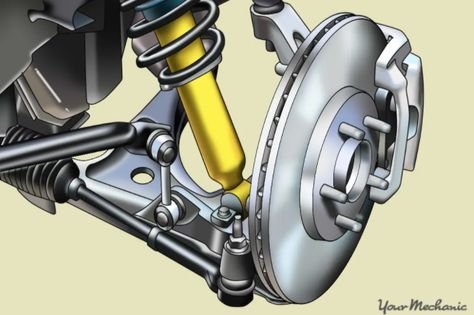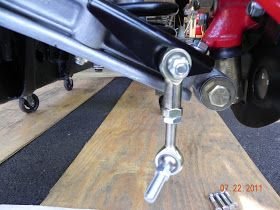Sway Bar Links The Ultimate Guide to Stability and Control

Sway bar links are a crucial component in a vehicle’s suspension system, helping to stabilize the car and improve handling during turns. Whether you’re a car enthusiast or a driver looking to understand your vehicle better, this article will cover everything you need to know about sway bar links their functionality, maintenance, and replacement.
Table of Contents
What Are Sway Bar Links?
Sway bar links, also known as stabilizer bar links, connect the sway bar to the suspension components. The sway bar itself is a metal rod designed to reduce body roll during cornering. The links act as a bridge, transferring force from one side of the suspension to the other. Without properly functioning sway bar links, your vehicle may feel unstable and unsafe during turns.
How Sway Bar Links Work
The primary purpose of sway bar links is to ensure the sway bar can do its job effectively. Here’s how they work:
- Force Distribution: When your car takes a turn, the suspension on the outside compresses while the inside suspension extends. Sway bar links help transfer the force evenly, reducing body roll.
- Stability: By minimizing the vehicle’s tilt, sway bar links contribute to better handling and a smoother ride.
Signs of Failing Sway Bar Links

Faulty sway bar links can lead to noticeable issues in your car’s performance. Here are common signs that indicate your sway bar links might need attention:
- Clunking Noises: A loose or damaged link can cause clunking sounds when driving over bumps.
- Poor Handling: If your car feels less stable during turns, the sway bar links may not be functioning correctly.
- Uneven Tire Wear: Damaged sway bar links can lead to uneven weight distribution, causing tires to wear unevenly.
Causes of Sway Bar Link Failure
Several factors can contribute to the failure of sway bar links:
- Wear and Tear: Over time, regular use can wear down the joints or bushings in the sway bar links.
- Corrosion: Exposure to moisture and road salt can cause the metal parts to rust, compromising the integrity of the links.
- Accidents: Hitting a curb or pothole can damage the sway bar links.
Importance of Maintaining Sway Bar Links
Properly maintained sway bar links are essential for a safe and comfortable driving experience. They enhance your car’s stability, especially during sharp turns or in challenging road conditions. Ignoring issues with sway bar links can lead to costly repairs and safety risks.
How to Inspect Sway Bar Links
Regular inspections of your sway bar links can help identify problems early. Here’s a step-by-step guide:
- Visual Check: Look for visible damage or wear, such as cracks or rust.
- Listen for Noises: Pay attention to any unusual sounds when driving over uneven surfaces.
- Manual Test: Gently push the sway bar to see if it moves excessively, which could indicate loose or damaged links.
Replacing Sway Bar Links
When replacement becomes necessary, knowing what to expect can save you time and money. Here’s what you should know:
- DIY Replacement: If you’re comfortable with car repairs, replacing sway bar links is a manageable task. It requires basic tools and a jack.
- Professional Help: For those less experienced, seeking a mechanic is the safest option. They can ensure the job is done correctly.
Choosing the Right Sway Bar Links
Selecting the appropriate sway bar links for your vehicle is crucial. Here are some tips:
- Check Compatibility: Ensure the links are designed for your car’s make and model.
- Quality Materials: Opt for durable materials like stainless steel or high-quality rubber bushings.
- Brand Reputation: Choose brands known for reliability and performance.
Costs Associated with Sway Bar Links
The cost of sway bar links varies based on several factors, including the type of vehicle and the quality of the parts. On average:
- Parts: High-quality sway bar links range from $20 to $100 per link.
- Labor: Professional replacement can cost between $50 and $150, depending on your location and vehicle type.
Tips for Prolonging the Life of Sway Bar Links
To maximize the lifespan of your sway bar links, follow these tips:
- Regular Maintenance: Schedule routine inspections as part of your vehicle’s maintenance.
- Avoid Harsh Driving: Sudden stops and sharp turns can put additional stress on the links.
- Keep Components Clean: Clean the suspension area to prevent dirt and debris from causing wear.
Common Myths About Sway Bar Links
There are several misconceptions about sway bar links. Let’s debunk a few:
- Myth: All suspension noises are due to sway bar links.
- Truth: While damaged sway bar links can cause noise, other components like shocks or bushings might also be at fault.
- Myth: Replacing one link is sufficient.
- Truth: It’s recommended to replace both sway bar links at the same time for balanced performance.
Advantages of Upgrading Sway Bar Links
Upgrading your sway bar links can significantly improve your vehicle’s performance:
- Enhanced Durability: High-quality upgrades last longer and perform better under stress.
- Improved Handling: Upgraded links can provide more precise control, especially in sports or off-road vehicles.
- Reduced Maintenance: Premium materials require less frequent replacements.
Frequently Asked Questions About Sway Bar Links

What Happens If I Drive With a Broken Sway Bar Link?
Driving with a damaged sway bar link compromises stability, making it unsafe, especially during sharp turns or emergency maneuvers.
How Often Should Sway Bar Links Be Replaced?
There’s no set timeframe for replacing sway bar links, but they typically last between 50,000 to 100,000 miles, depending on driving conditions.
Are Sway Bar Links Covered Under Warranty?
Many vehicle warranties cover sway bar links, but it’s best to check your specific warranty terms.
Also read Dallas Mavericks vs OKC Thunder Match Player Stats: A Comprehensive Analysis
Conclusion
Sway bar links play a vital role in your vehicle’s suspension system, ensuring stability, safety, and comfort on the road. By understanding how they work, recognizing the signs of wear, and maintaining them properly, you can extend their lifespan and enhance your driving experience. Whether you’re replacing or upgrading your sway bar links, investing in quality components and professional assistance ensures your vehicle performs at its best.





